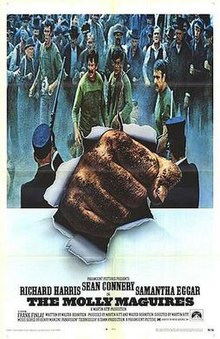The Molly Maguires (film)
| The Molly Maguires | |
|---|---|

Original promotional poster for The Molly Maguires
|
|
| Directed by | Martin Ritt |
| Produced by | Martin Ritt Walter Bernstein |
| Written by | Walter Bernstein |
| Starring | |
| Music by | Henry Mancini |
| Cinematography | James Wong Howe |
| Edited by | Frank Bracht |
| Distributed by | Paramount Pictures |
|
Release date
|
|
|
Running time
|
124 min. |
| Country | United States |
| Language | English |
| Budget | $11 million |
| Box office | $2,200,000 (US) |
The Molly Maguires is a 1970 American film based on a 1969 novel by Arthur H. Lewis that was directed by Martin Ritt. It stars Richard Harris and Sean Connery.
Set in late 19th century Northeastern Pennsylvania, this social drama tells the story of an undercover detective sent to a coal mining community to expose a secret society of Irish-American miners battling exploitation at the hand of the owners. Partly inspired by a true story, the film portrays the rebellious leader of the Molly Maguires and his will to achieve social justice.
The Molly Maguires were a secret organization of Irish coal miners established in nineteenth century Pennsylvania to fight oppressive mineowners. Led by Jack Kehoe (Sean Connery), they plant dynamite to destroy plant shafts and equipment. James McParlan (Richard Harris, as real life Pinkerton Detective James McParland) is employed to infiltrate the Mollies.
Kehoe and McParlan are working class immigrants from Ireland with essentially the same aspiration - advancement in the new society to which they have come. McParlan coldly betrays the group whose leader he has befriended and Kehoe kills to advance his cause. McParlan also develops a romantic interest in Mary Raines, but she ends up offended by his treachery.
Awaiting execution, Kehoe tells his erstwhile ally that no punishment short of hell can redeem his treachery; Detective McParlan retorts that in that case, "See you in hell."
The opening sequence of The Molly Maguires runs 14 minutes and 51 seconds, through three Henry Mancini scores, before the first word of dialogue is spoken.
The movie was filmed in Eckley, Pennsylvania, in 1969. The town was so unchanged from its 1870s appearance that the only major alterations needed for filming were to remove television antennas and install underground electric wiring.
A wooden coal breaker featured heavily in the film was built as a prop. It has received little or no maintenance over the years and, even though it has been called a tinderbox, it stands today — more than 40 years later.
...
Wikipedia
